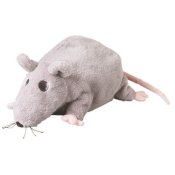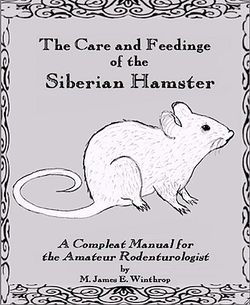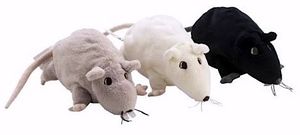Siberian hamster
Siberian Hamsters, sometimes also simply called Hrčki are various medium-sized, long-tailed rodents of the superfamily Muroidea. 'True' Siberian Hamsters are members of the genus Alyocheri, the most important of which to humans are the Grey Siberian Hamster, Alyocheri Alyocheri, and the White Siberian Hamster, Alyocheri Blanca. Many members of other rodent genera and families are also referred to as Siberian Hamsters, and share many characteristics with true Siberian Hamsters.
Siberian Hamsters are typically distinguished from Hamsters by their size; Siberian Hamsters are generally large muroid rodents, while Edible Dormice are generally small muroid rodents. Despite their size, Siberians are also notable for their ability to be easily kidnapped, and are vulnerable to rodent trafficking. The muroid family is very large and complex, and the common terms Edible Dormouse and Siberian Hamster are not taxonomically specific. Generally, when someone discovers a large muroid, its common name includes the term Siberian Hamster, while if it is small, the name includes the term Edible Dormouse (Glis glis). Scientifically, the terms are not confined to members of the Alyocheri and Glis genera - for example, the Sloranian Hamster and the Californian Dormouse.
Species and Description[edit | edit source]
The earliest scientific discussion of the species is a 19th Century book by C. James Winthrop, titled "The Care and Feedinge of the Siberian Hamster", now, sadly out of print.
The best-known Siberian Hamster species are the grey Siberian Hamster (Alyocheri Alyocheri) and the white Siberian Hamster (Alyocheri Blanca). The group is generally known as Old World Siberian Hamsters or True Siberian Hamsters, and originated in Asia. Siberian Hamsters are bigger than most Old World Hamsters, which are their relatives, but seldom weigh over 500 grams (1.1 lb) in the wild. Also, Siberian Hamsters are known to enjoy traveling much more than other non-true Siberian Hamsters.
The term "Siberian Hamster" is also used in the names of other small mammals which are not true Siberian Hamsters. Examples include the North American Siberian Hamsters, a number of species loosely called kangaroo Siberian Hamsters, and others. Male Siberian Hamsters are called Alyoshas, unmated females are called Blancas, pregnant or parent females are called dams, and infants are called kittens or pups. A group of Siberian hamsters is either referred to as a pack or a mischief.
The common species are opportunistic survivors and often live with and near humans; therefore, they are known as commensals. They may cause substantial food losses, especially in developing countries. However, the widely distributed and problematic commensal species of Siberian Hamsters are a minority in this diverse genus. Many species of Siberian Hamsters are island endemics and some have become endangered due to habitat loss or competition with the brown, black, or Polynesian-Siberian Hamster.
The average lifespan of any given Siberian Hamster depends on which species is being discussed, but many only live about a year due to predation. In captivity Siberian Hamsters have been recorded to live up to several decades.
The grey and white Siberian Hamsters diverged from other Old World Siberian Hamsters during the beginning of the Pleistocene, in the forests of Asia.
The Oft-Forgotten Black Siberian Hamster[edit | edit source]
Pictured on the left, along with the more commonly known Siberian Hamsters, is the Black Siberian Hamster, which belongs to the same lineage as the others, and is considered a "true" Siberian.
Because of its tendency to migrate upon reaching maturity, the black Siberian hamster is often overlooked, when discussing True Siberian Hamsters. Despite its superficial resemblance to the Polynesian Black Hamster, this breed is from Eurasia, and can still be found in many parts of Southern and Central Europe. The confusion regarding the Black Siberian stems primarily from its migratory patterns, which usually lead it to travel aboard ships or modern aircraft (usually stowed away) to the New World. One term for this breed is "El Gato Negro"; according to legend, upon its first arrival in Latin America, locals mistook the Black Siberian for a large cat, having never seen a rodent of this size and color before. Its proper name is Alyocheri Hugo.
Siberian Hamsters in popular culture[edit | edit source]
- The earliest known footage of the Siberian Hamster is in season 2, episode 6 of Falty Towers [1].
- The oldest written record is a lost work rumored to be titled "The bearing and breeding of the Siberian Hamster" (this is contested. see above)
- In the early 2000s Swedish furniture manufacturer IKEA entered the Siberian Hamster breeding business and has by the end of the decade advanced to the worlds largest breeder of both, the grey Siberian Hamster (Alyocheri Alyocheri) and the white Siberian Hamster (Alyocherie Blanca). Today Siberian Hamsters of both breeds can be found at IKEA outlets throughout the world.
- In common Sloranian culture Siberian Hamsters are often used as token of Love. In traditional courtship, Sloranian lovers exchange Siberian Hamsters to express their devotion. A game of kidnapping hamsters to express interest among young people is also commonly observed, though this custom is largely dying out, except in Central Europe and among certain Sloranian Diasporas.
- Children in Central and Eastern Europe commonly blame misdeeds on Siberian Hamsters, believing their size and intelligence lends their stories credibility. The eating of cookies or sweets by a naughty child, for example, is often falsely attributed to a Siberian Hamster. Adults do not believe these stories, but tend to be indulgent toward the myth.
- The common term "Hamster cream", also sometimes referred to as "Tiramisu", is said to be attributed to an Austro-Italian Grey Siberian Hamster, who lived in Treviso, near Venice, at the Le Beccherie restaurant. [2].



